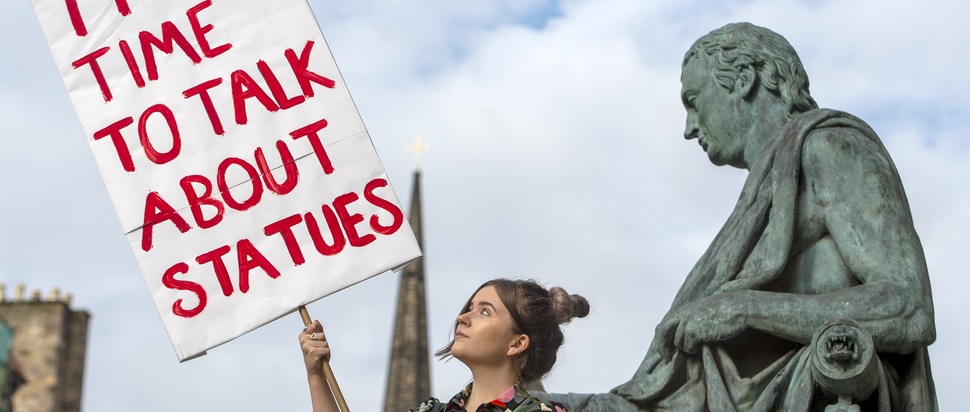New Histories: Talking Statues with Scottish Storytelling Festival
The Scottish International Storytelling Festival returns with a hybrid programme including a strand, Talking Statues, which asks us to reimagine who we choose to publicly memorialise
“Most folk will walk past statues without knowing who is being held in esteem," suggests Miriam Morris, the Scottish International Storytelling Festival's national development officer. "It’s important to know their stories and why they are there. Why do we look up to them, should we look up to them, who is missing from the skylines in our cities? Whose narrative deserves to be told, celebrated, and spotlit but their plinth is currently empty?” These are some of the questions the Storytelling Festival’s Talking Statues strand hopes to address.
The conversation around public statuary has never been more prominent; 2020’s submersion of the Colston statue created a tabloid-stoked binary narrative between erasure and permanent display that doesn’t reflect the nuance around how we choose to celebrate and record history. Morris says: “Statues celebrate, remember, and tell the stories of culturally or historically significant people. Often, statues are on a plinth that enables them to tower at a height above passers-by – we quite literally look up to them. They’re also, in some cases, public art.”
The public celebration of achievement can take many forms. In recent years, public art has diversified, moving away from casting big bronze figures to look at different ways to serve and engage the communities they are commissioned for. Are statues fit for purpose in 2021?
“I think they're relevant but it is time to get talking about them and share their stories,” explains Morris. “To understand why they are there, even if there are uncomfortable narratives attached to them.” This feels particularly relevant in Edinburgh, whose streets are littered with classical bronzes of old men of forgotten provenance. Many were shocked to discover that the figure towering over the city in St Andrew Square was the man who had delayed the abolition of slavery by well over a decade. Bringing this into the mainstream discourse has led to a broader re-examination of the city’s design, and the discovery that fixtures from street names to public buildings have been named after figures whose values we do not necessarily want to celebrate in the 21st century.
Talking Statues aims to continue this conversation and, says Morris, to “reclaim those stories and reclaim narratives that have not yet been told. Speaking about statues that currently exist also opens dialogues about those that don’t exist but should. It’s a great time to reimagine who should be on a plinth and tell their story.” To do this, the Storytelling Festival are inviting audiences to imagine who should be celebrated and memorialised, from family members to forgotten historical figures. “Stories give those from society that are perhaps voiceless or overlooked a chance to share their tales and contributions. Often from people who have been left out of the history books – women, LGBTQ+, ethnic minority groups and working-class narratives.”
The hope is that Talking Statues will lead to people engaging with history, exploring archives, recording family histories that may otherwise have been forgotten. A free event on 27 October, the Talking Statues Story Exchange, invites the public to register and come along to a virtual story sharing session. Says Morris: “You don't have to be a skilled storyteller. Simply acknowledging a person's name and why you're crediting them is enough. This is a platform to reclaim stories and to spotlight unheard ones.”
Beyond this, they want to prompt people to pay attention to their local statuary, to explore the figures who are being celebrated in their community. The process has led Morris to discover a new favourite in Prestonpans, close to where she lives, Statue to Alleged Witches Executed in Prestonpans by Andy Scott of Kelpies fame. “It’s a memorial to 81 women and men tortured and executed for allegedly being witches in that area," Morris says. "It’s a whole part of Scotland’s history that I didn’t know much about and it's right on my doorstep. From a quick Google of the statue, I’ve discovered a fascinating (albeit tragic) part of Scotland’s history that, quite frankly, I was ignorant to.”
To help this process of discovery, the Storytelling Festival have commissioned walking tours of Edinburgh in partnership with Mercat Tours so you can hear the tales of statues in Scotland and learn about the gaps missing in the city’s skyline.
Next year is Scotland’s Year of Stories, and Morris hopes Talking Statues will feed into that. “This is only the beginning of the conversation. I hope for this project to continue well beyond this year’s festival. It's a springboard to get sharing stories about Scotland’s history and connections and for people across Scotland to look at who is on show around them and why. Wouldn’t it be great if these conversations become a catalyst to erect an actual statue? Watch this space, I guess.”
Talking Statues Story Exchange, 27 Oct, 7-9pm, free
Part of the Scottish International Storytelling Festival, 15-31 Oct
Book tickets, join the conversation and find out more about walking tours at sisf.org.uk/get-creative-talking-statues/
